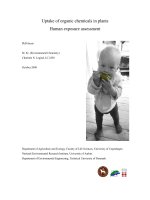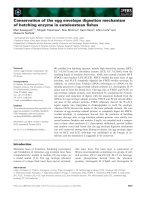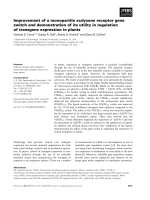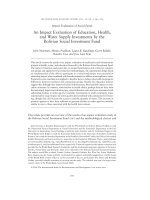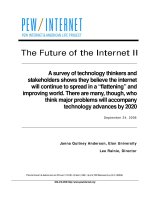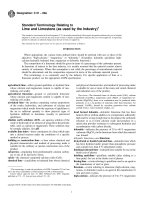Mechanism of action and binding mode revealed by the crystal structures of key enzymes in plants sugar metalbolic pathway
Bạn đang xem bản rút gọn của tài liệu. Xem và tải ngay bản đầy đủ của tài liệu tại đây (13.37 MB, 136 trang )
MECHANISM OF ACTION AND BINDING MODE
REVEALED BY THE CRYSTAL STRUCTURES OF KEY
ENZYMES IN PLANTS’ SUGAR METABOLIC PATHWAY
CHUA TECK KHIANG BSc (Hons)
A THESIS SUBMITTED FOR THE DEGREE OF DOCTOR
OF PHILOSOPHY AT THE NATIONAL UNIVERSITY OF
SINGAPORE
DEPARTMENT OF BIOLOGICAL SCIENCES,
FACULTY OF SCIENCE,
NATIONAL UNIVERSITY OF SINGAPORE
APRIL 2008
For Cherlyn
iii
Acknowledgements
I am grateful to my supervisor, Dr. J. Sivaraman, for an opportunity to
persue research in a field of my interest. His patience, perserverance and
dedication to science are invaluable lifetime lessons.
I would like to thank Prof. Bharat K Patel, Griffth University, Australia, for
the clones of sucrose phosphate synthas (SPS) and fructokinase (FRK). I
also thank Prof. Janusz Bujnicki (IIMCB, Warsaw, Poland) for his
collaboration on the bioinformatics part of SPS.
I would also like to thank Dr Anand Saxena, Brookhaven National
Laboratories (BNL) National Synchrotron Light Source, for assistance in
data collection. I wish to thank Mr Shashikant Joshi for extending the
Proteins and Proteomics Center facility. I also thank NUS for having given
me the opportunity to pursue my Ph.D. with a research scholarship.
My special thanks to all my labmates for their warm and unflinching
assistance. In particular, I wish to thank Cherlyn Ng, , Dr. Zhou Xingding,
Dr. Li Mo, Sunita Subramanian, Dr Tan Tien Chye, Dr. Kumar
iv
Sundramurthy, Lissa Joseph and for all the scientific/non-scientific
discussions and for being such great friends and colleagues.
v
Table of Contents
Page
Acknowledgements
iii
Table of Contents
v
Summary
vii
List of Tables
ix
List of Figures
x
List of Abbreviations
xiii
Publications
xvii
Chapter 1 : General Introduction
1
1.1 Introduction
2
1.2 Carbon
2
1.3 Key Enzymes of Source and Sink Tissues of Plants
3
1.4 Sugar
5
1.5 Sugar phosphates
6
1.6 Sucrose
7
1.7 Sucrose synthesis
8
1.8 Sucrose and environmental stress
10
1.9 Fate of synthesized sucrose
11
1.91 Starch synthesis 12
1.92 Glycolysis 13
1.10 Sugar phosphorylation in sucrose catabolism
14
1.11 Sugar kinases
16
1.11.1 Hexokinase superfamily 16
1.11.2 Galactokinase superfamily 16
1.11.3 Ribokinase superfamily (also known as pfkb
family in Prosite sequence collection)
16
1.12 Halothermothrix orenii
17
Chapter 2: Mechanism of Action and Binding Mode
Revealed by the Structure of Sucrose Phosphate
Synthase from Halothermothrix orenii
18
2.1
Introduction
19
2.2 Material and Methods
23
2.2.1 Cloning, expression and purification. 23
vi
2.2.2 MALDI-TOF analysis. 24
2.2.3 Dynamic Light Scattering (DLS). 24
2.2.4 Isothermal Titration Calorimetry (ITC). 24
2.2.5 Crystallization. 25
2.2.6 Data collection, structure solution and refinement.
25
2.2.7 Structure solution and refinement. 26
2.2.8 F6P-SPS and S6P-SPS complexes 26
2.2.9 Bioinformatics analyses. 27
2.2.10 Protein Data Bank accession code. 27
2.3 Results and Discussion
28
2.3.1 Sequence Analysis 28
2.3.2 Characterization of SPS 34
2.3.3 Crystallization and data collection 39
2.3.4 Overall Structure 42
2.3.5 Structural Comparisons to Other Proteins 43
2.3.6 SPS-F6P complex. 51
2.3.7 SPS-S6P complex. 52
2.3.8 Putative ADP / UDP binding pocket. 57
2.3.9 Mechanism of action. 63
Chapter 3: Mechanism of Action and Structure of
Fructokinase from Halothermothrix orenii
71
3.1 Introduction
72
3.2 Material and Methods
75
3.2.1 Cloning, expression and purification. 75
3.2.2 Crystallization. 79
3.2.3 Data collection, structure solution and refinement.
82
3.2.4 Structure solution and refinement. 83
3.3 Results and Discussion
84
3.3.1 Overall structure. 84
3.3.2 Sequence and structural similarity 87
3.3.3 Putative ATP binding pocket 92
3.3.4 Proposed mechanism of action 98
Chapter 4: Conclusions and Future Directions
103
References
106
vii
Summary
This thesis reports the structure and function of two key enzymes that represents a
valid model for the plant enzymes. Plant enzymes are relatively more difficult to isolate
and characterize. The plant homologs of the two enzymes taken for this thesis work,
namely Sucrose phosphate synthase (SPS) and Fructokinase (FRK), were particularly
shown to be highly unstable and could not be characterized. This motivated us to take the
Halothermothrix orenii as a model system for the plant enzymes to characterize the
structure and function. H. orenii and plant enzymes share significant sequence homology.
A detailed general introduction on the sugar metobolism enzymatic pathway is given in
the first chapter.
Sucrose phosphate synthase (SPS; EC 2.4.1.14) catalyzes the transfer of a
glycosyl group from an activated donor sugar such as uridine diphosphate glucose (UDP-
Glc) to a saccharide acceptor D-fructose 6-phosphate (F6P), resulting in the formation of
UDP and D-sucrose-6’-phosphate (S6P), a central and regulatory process in the
production of sucrose in plants, cyanobacteria and proteobacteria. The second chapter
reports the first crystal structure of SPS from H. orenii, and its complexes with the
substrate F6P and the product S6P. SPS has two distinct Rossmann-fold domains, A- and
B- domains, with a large substrate binding cleft at the interdomain interface. Structures of
two complexes show that both the substrate F6P and the product S6P bind to the A-
domain of SPS. The donor substrate, nucleotide diphosphate glucose (NDP-Glc), binds to
the B-domain of SPS based on comparative analysis of the SPS structure with other
related enzymes.
viii
Fructokinase (FRK; EC 2.7.1.4) catalyzes the transfer of phosphate group from an
ATP donor to a saccharide acceptor D-fructose resulting in the formation of D-fructose 6-
phosphate (F6P). As an irreversible and near rate-limiting step, it is important for
regulating the rate and localization of carbon usage by channelling fructose into a
metabolically active state for glycolysis in plants and bacteria. The third chapter reports
the crystal structure of FRK from Halothermothrix orenii, a first representative of any
species structurally chracterized, and the possible mechanism of action. FRK possesses a
β-sheet “lid” and an α/β (Rossmann-like) fold at its catalytic domain. FRK dimerization
is through the lid domain and held in a β-clasp form.
The conclusions and future directions are provided in the fourth chapter. Our
findings indicate that the H. orenii represent valid models of both plant SPSs and FRKs
and thus provide useful insight into the reaction mechanism of the plant enzymes. As
SPS has been implicated in stress response and food productivity, structure-based
mutagenesis of SPS in plants may result in high yielding crops with greater resistance to
osmotic fluctuations in the face of climate changes today.
ix
List of Tables
Page
Table 2.1 Data collection and refinement statistics of SPS 41
Table 3.1 Data collection and refinement statistics of FRK 82
x
List of Figures
Figure
Page
1.1 SPS and FRK roles in sugar metabolism in plants. 4
1.2 Haworth projection of fructose, a monosaccharide. 5
1.3 Molecular structure of sucrose. 7
1.4 The light-independent pathway of photosynthesis 9
1.5 The glycolytic pathway. 15
2.1 A schematic diagram of the reaction involving SPS
and F6P.
20
2.2 Sequence similarity between SPS and its homologs. 30
2.3 Phylogenetic tree of the SPS family. 31
2.4 Schematic diagram of H. orenii SPS with S.
tuberosum SPS (closest homolog of H. orenii SPS
belonging to Plant SPS), Synechocystis sp. PCC 6803
SPS and Synechocystis sp. PCC 6803 SPP.
32
2.5 SDS-GEL image of purified SPS. 34
2.6 Gel filtration profile of SPS. 35
2.7 MALDI-TOF MS results for native and
selenomethionyl SPS.
36
2.8 Dynamic Light Scattering results for SPS. 37
2.9 ITC profile of H. orenii SPS and substrate F6P. 38
2.10 Crystal of SeMet SPS. 39
2.11 Sample diffraction pattern of SeMet SPS crystal. 40
2.12 Ribbon diagram showing the structure of SPS. 44
2.13 Structure based sequence alignment of H .orenii
SPS.
46
2.14 Ribbon diagrams showing three complex structures
side-by-side
48
2.15 Superimposed, stereo diagram of the open SPS-F6P
complex (yellow) and the closed SPS-UDP model
(blue).
50
2.16 Simulated-annealing Fo-Fc omit map of (a) F6P and
(b) S6P in the substrate binding site of SPS
contoured at a level of 3.0σ.
53
2.17 (a) Molecular surface of SPS showing the distinct
two domains separated by a large substrate binding
cleft. (b) Close-up view of the F6P binding site. (c)
55
xi
Close-up view of the S6P binding site.
2.18 Superimposition of F6P-SPS and S6P-SPS
complexes.
56
2.19 Ten docked models of UDP interacting with the
binding residues of H. orenii SPS.
59
2.20 Ten docked models of ADP interacting with the
binding residues of H. orenii SPS.
60
2.21 Superimposition of one docked-UDP ligand and the
actual UDP ligand.
61
2.22 Superimposition of one docked-ADP ligand and the
actual ADP ligand
62
2.23 Superimposition of the catalytic regions of the open
SPS-F6P complex (cyan) and the closed SPS-S6P-
UDP model (magenta).
66
2.24 Schematic diagram of the reaction between F6P and
UDP-Glc in the binding cleft of SPS.
68
3.1 A schematic diagram of the reaction involving FRK
and Fructose.
72
3.2 Top a) SDS-GEL image of purified FRK. Bottom b)
Gel filtration profile of FRK.
77
3.3 Crystal of SeMet FRK. 80
3.4 Sample diffraction pattern of SeMet FRK crystal. 81
3.5 Crystal structure of HoFRK. 85
3.6 Structure based sequence alignment of HoFRK. 90
3.7 Stereo diagram of the conserved, binding residues
of RK (magenta; PDB code 1RKD) interacting with
both of its ligands ADP (white) and Ribose (white),
with the corresponding and conserved residues of
HoFRK (cyan) superimposed.
93
3.8 Stereo diagram of the conserved, binding residues
of RK (magenta; PDB code 1RKD) interacting with
both of its ligands ADP (white) and Ribose (white).
94
3.9 (a) Stereo diagram of HoFRK (cyan) and the
complex structures of the three ribokinase family
members, superimposed on the HoFRK model at
the catalytic domain.
95
xii
3.10 Superimposed ribbon diagram of HoFRK (cyan)
and RK-ADP (magenta-white) complex structure.
97
3.11 Stereo diagram of simulated-annealing Fo-Fc omit
map of residues in HoFRK.
100
3.12 (a) Molecular surface of HoFRK showing the
distinct domain and lid structural features
separated by a large substrate binding cleft.
101
xiii
List of Abbreviation
Å
angstrom (10
-10
m)
ADP-Glc adenosine diphosphate glucose
ATP
adenosine triphosphate
BME
β
-mercaptoethanol
CAZy
Carbohydrate Active Enzymes database
CNS
crystallography and NMR system
DEAE
diethyl aminoethyl
DLS
dynamic light scattering
DTT
Dithiothreitol
E. coli
Escherichia Coli
EDTA
ethylenediamine tetraacetic acid
F6P Fructose 6-phosphate
FPLC
fast performance liquid chromatography
FRK Fructokinase
GDP-Glc guanosine diphosphate glucose
GPGTF glycogen phosphorylase glycosyltransferase
GT Glycosyltransferases
xiv
H. orenii Halothermothrix orenii
IPTG
isopropylthogalactoside
ITC
isothermal titration calorimetry
kDa Kilodaltons
LB
Luria-Bertrani
MAD
multiwavelength anomalous dispersion
MALDI-TOF
Matrix Assisted Laser Desorption Ionization –Time of
Flight
MS mass spectrometry
NCBI National Center for Biotechnology Information
NCS non crystallographic restraints
nm Nanometer
OD optical density
ORF
OtsA
open reading frame
trehalose 6-phosphate synthase
PCR polymerase chain reaction
PEG polyethylene glycol
PolydIndx polydispersity index
rmsd root mean square deviation
rpm rotations per minute
xv
S6P Sucrose 6-Phosphate
SDS-PAGE sodium dodecyl sulfate - polyacrylamide gel electrophoresis
SPS Sucrose Phosphate Synthase
SS Sucrose Synthase
SeMet seleno-L-methionine
TP Triose phosphate
Amino acids
Ala (A)
Alanine
Arg (R)
Arginine
Asn (N)
Asparagine
Asp (D)
aspartic acid
Cys (C)
Cysteine
Gln (Q)
Glutamine
Glu (E)
glutamic acid
Gly (G)
Glycine
His (H)
Histidine
Ile (I)
Isoleucine
Leu (L)
Leucine
Lys (K)
Lysine
Met (M)
Methionine
Phe (F)
Phenylalanine
Pro (P)
Proline
xvi
Ser (S)
Serine
Thr (T)
Threonine
Trp (W)
Tryptophan
Tyr (Y)
Tyrosine
Val (V)
Valine
xvii
Publications
Mechanism of Action and Binding Mode Revealed by the Structure of Sucrose Phosphate
Synthase from Halothermothrix orenii
Chua Teck Khiang, Janusz M. Bujnicki, Tan Tien Chye, Frederick Huynh, Bharat K
Patel and J.Sivaraman (2008). The Plant Cell 20(4):1059-1072.
1
Chapter I
General Introduction
2
1.1 Introduction
Plants harness energy from sunlight through a series of chemical reactions to be
the earth’s primary producers of food. These important reactions are catalysed by
enzymes to which functional and structural characterization would greatly aid in
increasing the productivity of food to cope with the increasing human population. Plant
enzymes, however, are relatively difficult to isolate due to their instability in
heterologous systems. Fortunately, these enzymes possess homologs in many bacterial
systems that can be well-characterized. This motivated us to use Halothermothrix orenii
as a model system for understanding plant enzymes through structural chacterization. H.
orenii and plant enzymes share significant sequence homology. This thesis reports the
structures and their derived catalytic mechanisms of two ubiquitous enzymes in all plants,
sucrose phosphate synthase (SPS) and fructokinase (FRK), which represent valid models
for their plant counterparts.
1.2 Carbon
Carbon is an essential element in all living organisms. About 1900 gigatons of
carbon is present and continuously being exchanged between living and non-living
components of the biosphere in a biogeochemical process called the carbon cycle.
Inorganic carbon in the environment is unusable by organisms and needs to be converted
into organic form first. Auxotrophs (e.g. plants) do this through an anabolic pathway
called photosynthesis, using atmospheric carbon dioxide, water and sunlight:
6CO
2(gas)
+ 12 H
2
O
(liquid)
+ photons → C
6
H
12
O
6(aqueous)
+ 6 O
2(gas)
+ 6 H
2
O
(liquid)
3
There are two stages of photosynthesis. The light-dependant reaction is the first
stage, where light energy and cholophyll are used in photophosphorylation and photolysis
of water. Products from the light reaction are used in the next stage – known as the
light-independant reaction or Calvin cycle, where carbon dioxide is reduced into sugars.
The end products of photosynthesis are basic energy sources for all organisms as
substrates of respiration, a process through which sugar is oxidized back into carbon
dioxide to yield energy for growth and development.
1.3 Key Enzymes of Source and Sink Tissues of Plants
Most plant cells contain chloroplasts for the purpose of photosynthesis. The plant
organs involved in carbohydrate production are known as source tissues (Figure 1.1).
Most of the carbohydrate produced during photosynthesis converted to sucrose for
transport to other areas for storage, growth and respiration. Plant organs that utilize the
synthesized sucrose are known as sink tissues. SPS catalyses the production of sucrose-
6-phosphate in source tissues, the final substrate in the sucrose synthesis pathway. FRK is
a phosphotransferase at sink tissues; it produces fructose-6-phosphate from sucrose
breakdown, an important initiation substrate in many catabolic pathways such as
glycolysis.
4
Figure 1.1 SPS and FRK roles in sugar metabolism in plants.
Transport
SOURCE TISSUES
SINK TISSUES
CO
2
TP
Starch
Chloroplast
TP
F6P
S6P
Sucrose Cytoplasm
SPS
Sucrose
CO
2
UDP-Glc + Fru Fru + Glc
Invertase SS
FRK
F6P G6P
HK
Glycolysis
SPP
5
1.4 Sugar
Sugar (from the Sanskrit word sharkara) is a type of edible crystalline solid.
Scientifically, sugar refers to any type of monosaccharide (simple sugar) or disaccharide.
Monosaccharides (Greek: mono – 1; sacchar – sugar) are the basic building unit of
carbohydrates. Examples of monosaccharides include glucose, fructose, galactose,
ribose, xylose. Most monosaccharides self-cyclize between an alcohol group and a
carbonyl group to form a ring structure (Figure 1.2). Carbon 1 (C1) is the carbon atom of
the aldehyde group or the carbon atom immediately adjacent to a ketose group.
Figure 1.2 Haworth projection of fructose, a monosaccharide.
(
Disaccharides are sugar molecules with two monosaccharide units joined by a
glycosidic bond in a condensation reaction between their respective hydroxyl groups.
Sucrose (Figure 3) comprises of a fused glucose and fructose unit at a α(1→2) linkage,
lactose of galactose and glucose in a β(1→4) linkage, maltose of two α(1→4) linked
glucose entities. alpha- or beta- refers to the stereochemistry of the bond and (1→4) the
carbon at which the linkage is formed.
1
2
3
4
5
6
6
Sugars are central compounds in nature that serve as essential metabolic nutrients
and structural components for most organisms. They are also major regulatory molecules
that control gene expression, metabolism, physiology, cell cycle, and development in
prokaryotes and eukaryotes. In plants, it has been shown that sugars regulate the
expression of a broad spectrum of genes involved in many essential processes.
Furthermore, sugars affect developmental and metabolic processes throughout the life
cycle of the plant. These processes include germination, growth, flowering, senescence,
photosynthesis and sugar metabolism.
1.5 Sugar phosphates
Sugar phosphates are abundant in cells and important compounds in nature. They
are intermediates common to pathways of synthesis and degradation and therefore the
principle site at which pathways converge. Sugar phosphates are derived from
breakdown of polysaccharides, photosynthesis and gluconeogenesis. Common examples
are triose phosphate (TP), formed during photosynthesis and basic substrates for amino
acid and complex carbohydrate synthesis. Glucose-6-phosphate (G6P) and glucose-1-
phosphate (G1P) are the basic reactants in starch metabolism, and can be interconverted
or converted to fructose-6-phosphate (F6P) by phosphoglucomutase, glucose-6-isomerase
for oxidation through the glycolytic pathway. F6P itself is both a substrate and product
of sucrose biosynthesis and hydrolysis respectively, while sucrose-6-phosphate (S6P) is
an intermediate during synthesis of sucrose. Taken together, sugar phosphates form a
pool from which intermediates can be drawn or added to.
7
1.6 Sucrose
Figure 1.3. Molecular structure of sucrose. α(1→2) disaccharide formed by linking
carbon atom 1 of glucose and carbon atom 2 fructose monosaccharides.
(
Sucrose is a α(1→2)
disaccharide of glucose and fructose (Figure 1.3). It is solely
formed by plants where it has three fundamental and interrelated roles. First, it is the
principal product of photosynthesis and accounts for most of the CO
2
absorbed by a plant
in this process. Secondly, sucrose is a major transportable metabolite through which
carbon is translocated from source to sink tissues through plants’ vascular system.
Thirdly, sucrose is the main storage sugar in plants, serving as a main source of organic
carbons for the synthesis of structural elements and the production of energy in future
growth. Lastly, it acts as an osmolyte to prevent water loss in times of stress.
8
1.7 Sucrose synthesis
Most of the carbon needed for the production of sucrose originate from triose-
phosphate molecules produced by the light-independent pathway of photosynthesis, when
carbon dioxide is reduced by reacting with ribulose 1,5-bisphosphate to form two
molecules of glycerate 3-phosphate. By using ATP and NADPH from the light dependant
reactions, glycerate 3-phosphate is further reduced to triose phosphate. Triose phosphate
is a three-carbon sugar. One out of six molecules produced will condense to form
fructose 6-phosphate, which is then exported to the cytoplasm of a plant cell for sucrose
synthesis. Only a small amount of ready-made hexose molecules, produced in the
chloroplasts, are transported to the cytoplasm and are utilized for sucrose synthesis. The
rest of TP molecules are recycled to form ribulose 1,5-bisphosphate (Figure 1.4).
The reaction following triose phosphate production occurs in the cytoplasm. The
first step is the priming of glucose by glucose phosphorylase. This involves attaching a
UDP moiety:
Glucose-1-phosphate + UTP ↔
↔↔
↔ UDP-glucose +PPi
The amount of F6P available is held in equilibrium by the interconversion of
fructose-1,6-bisphosphate (FBP) and F6P through the action of three enzymes, which are
also key regulatory points in the synthesis of sucrose. Cytosolic fructose-1,6-
bisphosphatase (cyFBPase) produces F6P from FBP and is inhibited by fructose-2,6-
bisphosphate. Conversely, phosphofructokinase catalyzes the backward reaction to FBP
from F6P. Pyrophosphate:fructose-6-phosphate-1-phosphotransferase (PFP) is able to


